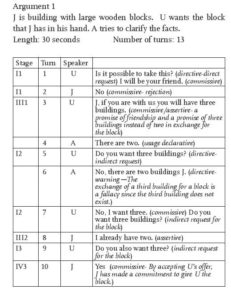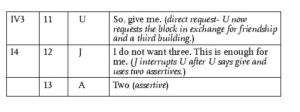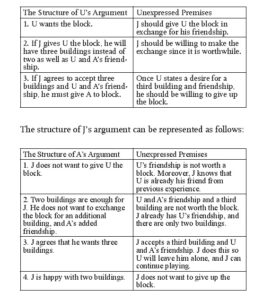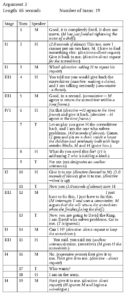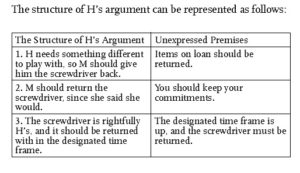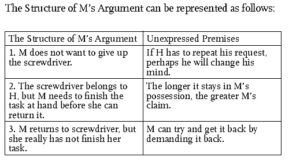ISSA Proceedings 2006 ~ An Analysis Of Preschool Hebrew Speaking Children’s Arguments From The Perspective Of The Pragma-Dialectical Model
No comments yet 1. Characteristics of Children’s Verbal Arguments
1. Characteristics of Children’s Verbal Arguments
Verbal arguments are part of young children’s normal activity and are usually “rule governed and socially organized events” (Benoit 1992, p. 733). Researchers have concluded that they have a positive effect on friendships and cognitive development (Corsaro 1994, Dawe 1934, Garvey 1993, Green 1933, and Shantz 1987). Corsaro (1994, p. 22) states “disputes provide children with a rich arena for development of language, interpersonal and social organization skills, and social knowledge.” In fact, O’Keefe and Benoit (1982) see argument as part of normal language learning. Piaget (1952, p. 65) states “[i]t may well be through quarrelling that children first come to feel the need for making themselves understood”.
Children’s arguments are generally short in duration. For example, Dawe (1934) found that on average quarrels last 14 seconds, while O’Keefe and Benoit (1982) found that young children’s disputes consisted of an average of five turns. Although these disputes are not long in duration, they are powerful events. Once a dispute has begun, “any prior goal or task is abandoned and the attention is directed to resolving the incompatibility” but “[o]nce the conflict is resolved, play can once again be resumed” (Eisenberg and Garvey 1981, p.151). These verbal disputes can be considered as “side-sequences” (Jefferson, 1972), important at the moment, but with no lasting effect on interaction.
2. The Study and Research Question
This paper will report on ongoing research investigating the verbal arguments of Hebrew speaking pre-school children. The data for this research was transcribed from videotapes of fourteen triads of pre-school children at play in a playroom that was set up for the purpose of the study. The children are also in daily attendance at the same pre-school. The subjects’ ages ranged from 4 years six months to six years five months, however the maximum age differences of the children in each individual group was usually around six months. Children above the age of four were chosen since by this age normally developing children have acquired the basics of their language system (Brown, 1973). The children were all native speakers of Hebrew. While the children conducted their talk in Hebrew it was transcribed and translated simultaneously into English by the author.
While this is an ongoing study with a number of research questions, only one of these will be related to in this paper. This question is presented below:
Is the process of Israeli preschool children’s arguments consistent with the pragma-dialectical model of van Eemeren and Grootendorst (2004)?
3. The Pragma-Dialectical Model (van Eemeren and Grootendorst 2004)
By using the pragma-dialectical model for critical discussion to reconstruct an
argument, we are able to see its deeper structure. Since the model is informed by speech act theory (Searle 1976), this will allow for the investigation of both the children’s pragmatic ability and of their ability to sustain an argument.
The model has four discussion stages. These are confrontation, opening, argumentation, and concluding. In the confrontation stage, it becomes clear that there is a difference of opinion. In the opening stage the parties “try to find out how much relevant ground they share (as to the discussion format, background knowledge, values and so on)” (van Eemeren and Grootendorst 2004, p. 60). In the argumentation stage protagonists advance their argument, and if antagonists are not convinced, they will give further arguments, and finally in the concluding stage the argument is resolved to the satisfaction of the protagonists and the antagonists. Nevertheless, van Eemeren and Grootendorst recognize that this is an ideal model and that not all arguments go through all four stages, nor do all arguments go through the stages in order.
Searle (1976) distinguishes five basic kinds of speech acts. These are assertives (also known as representatives), directives, commissives, expressives, and declarations. Assertives are statements of fact that may be either true or false such as “But somebody needs to sleep in the bed” (the examples are from the corpus of the study). Directives are requests or commands, which can be made directly (“give it back to me”), or indirectly (“Do you want three buildings [I will give you a building if you give me the block]”), questions are directives as well. Commissives commit the speaker to “some future course of action” such as a promise or a threat, for example, “I will be your friend [if you give me the block]”) (Searle 1976, p. 11). Declarations must have some kind of official backing and authority such as a judge sentencing a criminal to a jail term, or in our case “I am (King) David, who solves the problems [(if you come to me I have the authority to solve your problems]”). While declarations have no place in the model, van Eemeren and Grootendorst do suggest a sub-type of speech act that they call ‘usage declarative’. Usage declaratives are definitions, specifications, amplifications and explanations to help the listener understand other speech acts (“There are two, two [J don’t accept what U says, there are only two buildings]”). Different kinds of speech acts are used in the four stages to bring the argument to resolution. While participants in an argument may use expressives, these do not aid in advancing an argument; only assertives, directives, and commissives are relative to the resolution of an argument.
4. Analyses of Two Verbal Arguments
Two verbal arguments will be analyzed below from the perspective of the pragma-dialectical model. The first is an argument between two boys. J is who is four years and nine months old is the protagonist, U is who is five years old is the antagonist. In addition, A who is four years and six months old is a participant observer who tries to clarify an error in U’s argument. The boys had previously divided the room into J’s territory and A and U’s territory. This behavior is very common in the play behavior of young children (Ariel and Sever 1980). J is building with large wooden blocks in his area of the room; there are two separate buildings in J’s area. U wants a block J is holding in his hand. Disputes over object possession are very common among children. In fact, the majority of disputes among English speaking children are over object possession. (Dawe 1934, Eisenberg and Garvey 1981, Howe and McWilliam 2001).
In turn one U uses a directive, making a request for the block. To make the request more attractive he adds a promise of his friendship and uses a commissive. This is the confrontation stage. It is now up to J to accept or reject the offer. When he says “no” he refuses U’s request and also performs a commissive. This is still the confrontation stage. Now, the players may move on to the opening stage. Yet, they leave this stage out and move straight on to the argumentation stage. U makes J an offer of A’s friendship as well as his own by performing a commissive and making an assertion that J will have three buildings if he allies himself with U and A. Nevertheless, A sees U’s mistakes and points out that there are only two buildings. This can be seen as a usage declarative since it is an attempt to help J understand that U’s offer is flawed – there really are only two buildings. In turn 5 there is a second confrontation and U uses an indirect directive by asking J if he wants three buildings (in exchange for the block). U does not need to make a direct request for the block again since according to the “Rule of Reinstating Request” (Labov and Fanshel 1977, p. 94) once a request has been made (turn 1) it is in effect and does not need to be restated. Again A feels the need to correct U. This time he uses a directive in the form of a warning to J. Now U commits himself to wanting three buildings, and again asks J to be with him and A so U can have three buildings and the block. J goes on to the argumentation stage and uses an assertive when he says he already has two. Again U asks J if he wants three buildings. This is the third confrontation. He is again requesting the block in exchange for three buildings and friendship. Now we come to the concluding stage when J finally says, “Yes” and agrees. U again requests the block for the fourth time by asking for it directly (“so give it to me”) since J has finally committed himself. In the next turn J rejects U’s requests by using assertives – “I do not want three” (and I do not want to give you the block or be your friend) “This is enough for me” to make his point. This is the fourth confrontation in the argument, but the argument does not continue since U has either given up or lost interest and walks away. Another explanation for U’s not continuing with the argument is J’s interruption in turn 12. Lein and Brenneis (1978) found that among white American middle class children simultaneous speech during a dispute would bring the argument to an abrupt halt. Finally, A cannot resist and must get in the last word (two).
To reveal the deep structure of the argument van Eemeren and Grootendorst (2004) propose making an analytical overview by performing analytical transformations. These include:
Deletion: of all those parts of the discourse or text which are not relevant to the resolution of the difference of opinion at issue.
Addition: of relevant parts that are implicit (unexpressed premises)
Substitutions: by the replacement of formulations that are confusingly ambiguous.
Permutations: require part of the discourse or text to be rearranged where necessary in a way that best brings out their relevance in the resolution process.
By using, deletion and addition, we can discover the structure of each participant’s arguments in the above-mentioned argument. For example, the structure of U’s argument and J’s arguments can be represented in the tables below (adapted from van Eemeren and Grootendorst 2004, p. 122)
The second argument is between M the protagonist, who is a six-year-old girl, and the antagonist H who is six years two months in age. Again, there is a participant observer. T is a boy who is six years and four months old and offers his services as a mediator. Again this is an argument over object possession, but unlike U who never received the object he desired, H does succeed in getting the object, in this case a toy screwdriver, away from M. This may be because of his persuasive skills or simply because he had had possession of the object originally. For example, Bakeman and Brownlee (1982, p. 108) found that the resolution of “possession episodes” among young children often had a social base and not a power base, that is previous possession of an object gives a child the right to that object. Bakeman and Brownlee refer to this as the “prior possession rule”.
The preliminary stage of this argument begins when M declares that she has completely finished fixing the shelf. At this point in time H is playing with some clothes, which he and T found previously. He speaks to M and uses a directive and makes an indirect request for the screwdriver followed by a direct request. This is the first confrontation. When M replies with “What” she uses a directive for clarification. Again, the disputers could go on to the opening stage, but instead H uses an assertive that he considers a true fact and presents an argument (argument 1) of why M
should return the screwdriver. H’s argument is actually flawed. Although he had played with the screwdriver first, he gave it to M without any stipulations. M presents her argument with a commissive and agrees to return it within a certain time frame. She may have forgotten that she had not actually said she would return the screwdriver, or it may have been clear to her from the beginning that it was only on loan. In turn 6, H goes to the concluding stage, using two directives and agrees to the time frame. At this point T understands that there is an argument and offers his services as a mediator. In turn 10, H uses a directive as a direct request for the screwdriver, then waits three seconds and makes another direct request that tells M her time is up. This is the second confrontation. Again T offers his services to no avail. In turn 12, M uses a commissive and again offers the argument that she will return the screwdriver within a certain time frame. Again T offers his services, this time as King David from the bible no less. In line 14, M goes on to the third confrontation and uses a direct request for the screwdriver, but H has lost his patience and interrupts M. H uses an assertive and reminds M of what she said previously. This is the argumentation stage of the third confrontation. M finally gives H the screwdriver since her time frame was finally up. Yet, in turn 16 M regrets her action and begins a fourth confrontation. She first uses the expressive ‘no’ to protest her action, and then a direct request for the screwdriver back. However H has gone on to some private play and begins a monologue. Finally even though M again uses a directive as a direct request she is ignored. If we look at the structure of each participant’s argument we will see the following:
5. Discussion and Conclusions
If we compare the two arguments, we can see that they both leave out the opening stage. Perhaps this is due to the fact that the children are so well acquainted with rules of their mini-society that they are already aware of what they share together and, thus, find it unnecessary to elaborate further, or perhaps they are just too intellectually immature to engage in the opening stage.
In both arguments it seems difficult to find a solution that is satisfactory to all participants through argumentation. In the first argument the antagonist simply lost interest, and in the second argument once the antagonist had what he wanted he went on to something else, while the protagonist was certainly unhappy with the outcome and tried to reopen the argument to no avail. Nevertheless, we can see that these pre-school children are capable of sustaining an argument from the confrontation stage until the concluding stage.
Furthermore, we can see the children do use the speech acts available to them according to the pragma-dialectical model to try and resolve their arguments. Thus, we can conclude that the process of the children’s arguments is consistent with the pragma-dialectical model. However, perhaps more importantly for the study of child language is that by using the pragma-dialectical model we can see how children use various speech acts and organize their arguments.
Finally, the model is very useful in the understanding of the structure of each child’s thought processes. Therefore, I have concluded that the model can be a valuable tool to help us better understand children’s verbal arguments.
References
Ariel, S. & I. Sever. (1980). Play in the desert and play in the town: on play activities of Bedouin Arab children. In: H. M. Schwartzman (Ed.), Play and Culture (pp. 164- 175), West Point: Leisure Press.
Bakeman, R. & J.R. Brownlee (1982). Social rules governing object conflict in toddlers and preschoolers. In: K. H. Rubin & H. S. Ross (Eds.), Peer Relationships and Social Skills in Childhood (pp. 99-111), New York: Spring-Verlag.
Benoit, P. J. (1992). The use of argument by preschool children: the emergent production of rules for winning arguments. In: W.L. Benoit, A. Hample, & P.J. Benoit (Eds.), Readings in Argumentation (pp. 711-736), New York: Foris Publications.
Brown, R. (1973). A First Language. Cambridge: Harvard University Press.
Corsaro, W. A. (1994). Discussion, debate and friendship processes: peer discourse in US and Italian nursery schools. Sociology of Education, 67, 1-26.
Dawe, H.C. (1934). An analysis of two hundred quarrels of preschool children. Child Development, 5, 146-158.
Eemeren, F. H. van, & R. Grootendorst (2004). A Systematic Theory of Argumentation. Cambridge: Cambridge University Press.
Eisenberg, A. R. & C. Garvey (1981). Children’s verbal strategies in resolving conflicts. Discourse Processes, 4, 149-170.
Garvey, C. (1993). Diversity in the conversational repertoire: the case of conflicts and social pretending. Cognition and Instruction, 11 (3&4), 251-264.
Green, E.H. (1933). Friendship and quarrels among preschool children. Child Development, 4, 237-252.
Howe, C & D. McWilliam (2001). Peer argument in educational settings: variations due to socioeconomic status, gender and activity context. Journal of Language and Social Psychology, 20: 1/2, 61-80.
Jefferson, G. (1972). Side sequences. In: D. Sudnow (Ed.), Studies in Social Interaction (pp. 294-338), New York: The Free Press.
Labov, W. & D. Fanshel (1977). Therapeutic Discourse: Psychotherapy as Conversation. New York: Academic Press.
Lein, L. & D. Brenneis (1978). Children’s disputes in three speech communities. Language in Society, 7:299-323.
O’Keefe, B. J. & P.J. Benoit (1982). Children’s arguments. In J. R. Cox and C. A. Willard (Eds.) Advances in Argumentation Theory and Research (pp. 154-183) Carbondale: Illinois Press.
Piaget, J. (1955). The Language and Thought of the Child. Tr. Marjorie Gabain. New York: Meridian Book.
Searle, J. R. (1976). The classification of illocutionary acts. Language in Society, 5(1): 1-23.
Shantz, C. (1987). Conflicts between children. Child Development, 58, 283-305.
You May Also Like
Comments
Leave a Reply
